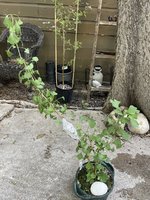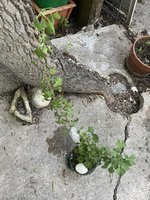BonsaiOnTheBrainTX
Mame
Hello everyone,
I recently started my first 2 air layers. One from a large in ground Pear Tree and one on a little Ginko Biloba “Elmwood”.
I need some help on the Ginko. I started this air layer 19 days ago. The tree has been healthy and has been growing pretty vigorously the last couple months. You can see in the picture it has 2 trunks. The one on the left is much taller and doesn't have a single branch .
.
I wanted to prune it down shorter than the right trunk and hopefully encourage some branching, so I thought it would be a good opportunity to air layer. The last 48 hours the leaves above the air layer have started to wilt and just gone limp. Even after watering. So I’m wondering what I should do. My first thought is to go ahead and chop it off, remove the foil, stick it in a pot and hope for the best. But I would love to hear from people with more experience that may have some feedback or advice.
See attached thanks!
I recently started my first 2 air layers. One from a large in ground Pear Tree and one on a little Ginko Biloba “Elmwood”.
I need some help on the Ginko. I started this air layer 19 days ago. The tree has been healthy and has been growing pretty vigorously the last couple months. You can see in the picture it has 2 trunks. The one on the left is much taller and doesn't have a single branch
I wanted to prune it down shorter than the right trunk and hopefully encourage some branching, so I thought it would be a good opportunity to air layer. The last 48 hours the leaves above the air layer have started to wilt and just gone limp. Even after watering. So I’m wondering what I should do. My first thought is to go ahead and chop it off, remove the foil, stick it in a pot and hope for the best. But I would love to hear from people with more experience that may have some feedback or advice.
See attached thanks!


